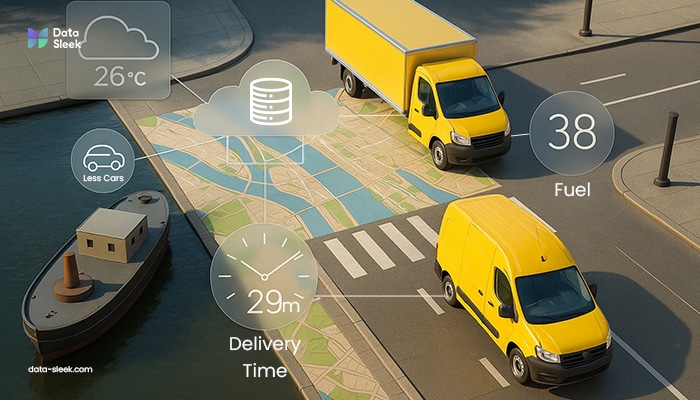In today’s hyper-competitive logistics landscape, transportation companies face unprecedented challenges: volatile fuel costs, unpredictable weather patterns, and ever-increasing customer expectations for faster deliveries. The difference between industry leaders and those struggling to keep pace often comes down to one critical factor: how effectively they leverage their data. Industry research indicates that logistics companies implementing data-driven decision-making often see significant reductions in operational costs and meaningful improvements in on-time deliveries.

Transportation real-time data warehousing has emerged as the backbone of intelligent supply chain operations, transforming how companies optimize routes, respond to weather conditions, and schedule freight movements. This article explores how real-time data feeds are revolutionizing transportation operations and creating sustainable competitive advantages in freight management.
The Evolution of Transportation Data Management
From Paper to Powerhouse
The journey of logistics data management has been remarkable. Not long ago, transportation companies relied on paper manifests, radio communications, and manual planning boards to coordinate complex supply chain operations. Information silos were the norm, with crucial data scattered across departments, creating inefficiencies that cost time and money.
The digital transformation began with basic tracking systems but has evolved dramatically with transportation data warehousing solutions that serve as centralized repositories for all operational information. Today’s logistics data management systems integrate data from multiple sources—GPS tracking, ELD (Electronic Logging Device) systems, weather services, traffic monitoring, and customer management platforms—creating a unified view of operations.
Pain Points Addressed by Centralized Data Solutions
Traditional transportation management systems face several critical challenges:
- Fragmented visibility across fleet operations, shipment status, and external conditions
- Delayed decision-making due to outdated or inaccessible information
- Inefficient resource allocation resulting from manual planning processes
- Limited predictive capabilities to anticipate disruptions or opportunities
Transportation data warehousing addresses these challenges by creating a single source of truth that enables real-time visibility and proactive management across the entire supply chain.
Understanding Real-Time Data Warehousing for Transportation
Core Components of Modern Logistics Data Architecture
Real-time transportation data warehousing differs fundamentally from traditional database systems. While conventional databases record historical transactions, modern logistics data optimization platforms continuously ingest, process, and analyze data streams from multiple sources simultaneously.
Key components include:
- Data Integration Layer – Connects to IoT sensors, telematics devices, ELDs, and third-party information sources
- Stream Processing Engine – Analyzes incoming data in real-time for immediate operational decisions
- Storage Infrastructure – Combines hot data (immediate access) with historical archives for pattern recognition
- Analytics and Visualization Tools – Transforms complex data into actionable insights for dispatchers and managers
The technology stack powering these systems typically includes cloud infrastructure, specialized ETL (Extract, Transform, Load) processes optimized for transportation data, and industry-specific analytics platforms designed for logistics applications.
Route Optimization Through Data Integration
The Real Cost of Inefficient Routing
Inefficient routing doesn’t just waste fuel—it creates a cascade of negative impacts across operations. A single unnecessary mile across a fleet of 100 vehicles translates to thousands of dollars in direct costs annually. Add maintenance expenses from excess wear, driver compensation for unproductive hours, and missed delivery windows, and the financial impact becomes substantial.
Transportation data warehousing enables sophisticated route optimization by combining:
- Historical performance data showing typical travel times between locations
- Real-time traffic information identifying congestion and incidents
- Vehicle-specific parameters like size restrictions, fuel efficiency, and load characteristics
- Driver availability and hours-of-service status ensuring compliance with regulations
Dynamic Routing in Action
When integrated properly, fleet data optimization systems automatically adjust routes based on changing conditions. If unexpected traffic develops, real-time freight data triggers automatic recalculation, rerouting vehicles and updating estimated arrival times for all stakeholders.
Industry research shows that logistics providers implementing transportation data warehousing with real-time routing optimization typically achieve significant reductions in total miles driven while simultaneously improving on-time delivery performance. The resulting fuel savings often represent one of the most immediate and measurable returns on investment, particularly for mid-sized and larger fleets.
Weather Intelligence for Proactive Operations
When Weather Becomes a Supply Chain Variable
Weather events represent a significant cause of freight delays across North America each year, resulting in substantial financial impact on the industry. Traditional approaches to weather management in transportation have been largely reactive—waiting for conditions to deteriorate before adjusting operations.
Real-time data warehousing transforms this approach by integrating sophisticated weather forecasting directly into operational systems. Rather than treating weather as an external disruption, supply chain predictive analytics platforms incorporate weather intelligence as a core planning variable.
Predictive Weather Integration
Modern transportation data warehousing solutions integrate multiple weather data sources:
- Short-term forecasts (0-24 hours) for immediate route adjustments
- Medium-range predictions (1-7 days) for proactive load planning
- Seasonal pattern analysis for strategic capacity planning
- Weather event severity assessments to trigger contingency protocols
When severe weather threatens a shipping lane, logistics data optimization systems can automatically identify affected shipments, calculate impact probabilities, and propose alternative routing or scheduling—often before the first raindrop falls.
Freight Scheduling Optimization
Beyond Static Load Planning
Traditional freight scheduling follows predictable but inflexible patterns. Routes are established, vehicles assigned, and schedules created—often days or weeks in advance. While providing operational stability, this approach fails to capitalize on dynamic opportunities or respond efficiently to disruptions.
Real-time freight data transforms scheduling into a fluid, continuously optimized process. Transportation data warehousing enables:
- Dynamic load consolidation to maximize vehicle utilization
- Continuous delivery sequence optimization based on changing priorities
- Opportunistic backhaul matching to reduce empty miles
- Automated appointment scheduling that adapts to actual progress
Balancing Capacity and Service Commitments
The most sophisticated logistics data management platforms balance multiple competing priorities simultaneously. When a high-priority delivery emerges, the system doesn’t simply expedite that shipment—it recalculates the entire network effect, preserving service commitments while maximizing overall efficiency.
These systems incorporate business rules, customer priority levels, and contractual service commitments alongside pure efficiency metrics, ensuring business relationships remain strong while operations become more efficient.
Implementation Strategies for Transportation Companies
Assessing Your Current Data Architecture
Before implementing transportation data warehousing solutions, companies should evaluate their current capabilities:
- Data Inventory Assessment – Identify all existing data sources across operations
- Integration Capability Evaluation – Assess how readily current systems can connect to a centralized platform
- Process Mapping – Document how decisions are currently made and where data could improve outcomes
- Skill Gap Analysis – Determine what additional expertise might be needed to leverage new capabilities
Building a Business Case for Data Transformation
Successful implementation requires strong organizational alignment. Key elements of an effective business case include:
- Current State Analysis – Quantify existing inefficiencies and their financial impact
- Opportunity Assessment – Project specific improvements in key metrics like fuel utilization, vehicle productivity, and on-time performance
- Implementation Roadmap – Outline phased approach with clear milestones
- ROI Projections – Detailed financial analysis with expected payback period
Most transportation companies find that fleet data optimization initiatives deliver positive ROI within 12-18 months when properly implemented.
Measuring ROI from Data Warehousing Investments
Key Performance Indicators for Transportation Data Initiatives
Measuring the success of transportation data warehousing implementations requires monitoring specific metrics:
- Fleet Utilization Rate – Percentage of available capacity productively employed
- On-Time Delivery Performance – Reliability of meeting scheduled delivery windows
- Miles Per Gallon – Fuel efficiency across the fleet
- Empty Mile Percentage – Proportion of travel without revenue-generating cargo
- Dwell Time – Non-productive waiting periods at facilities
- Maintenance Cost Per Mile – Indicator of equipment health and preventive maintenance effectiveness
Real-World Results from Supply Chain Analytics
Companies implementing comprehensive logistics data optimization often report improvements across multiple operational dimensions. Transportation data warehousing solutions can help organizations achieve:
- Reduction in total miles driven through improved routing and load consolidation
- Decrease in preventable maintenance events through predictive maintenance
- Improvement in driver retention from more predictable schedules and reduced frustration
- Reduction in customer service inquiries due to proactive status updates
The specific results vary by organization size, industry segment, and implementation approach, but the pattern of multi-dimensional improvement is consistent across successful deployments.
Future Trends in Transportation Data Warehousing
AI and Machine Learning Applications
The next frontier in transportation data warehousing leverages artificial intelligence to move from descriptive analytics (what happened) to prescriptive recommendations (what should happen). Machine learning algorithms continuously improve by analyzing outcomes against predictions, creating ever-more-accurate optimization models.

Internet of Things (IoT) Integration
The proliferation of IoT devices throughout the supply chain creates new opportunities for visibility. Beyond vehicle telematics, sensors now monitor:
- Cargo conditions (temperature, humidity, shock events)
- Equipment health indicators (component vibration patterns, fluid levels)
- Facility status (dock availability, yard congestion)
- Infrastructure conditions (road surface quality, bridge clearances)
Edge Computing for Instant Decisions
While centralized data warehousing remains essential for enterprise-wide optimization, edge computing brings analytical capabilities directly to vehicles and facilities. This hybrid approach enables instant, autonomous decisions while feeding outcomes back to the central system for continuous improvement.
Blockchain for Secure Data Sharing
As supply chains become increasingly collaborative, secure data sharing across organizational boundaries becomes critical. Blockchain technologies are emerging as a trusted mechanism for selective information sharing between partners while maintaining data sovereignty.
Conclusion: Transforming Transportation Through Data
Real-time data warehousing has evolved from a competitive advantage to a competitive necessity in transportation and logistics. Companies that successfully implement centralized, real-time data solutions gain unprecedented visibility and control over their operations—transforming from reactive to proactive management.
As you consider your organization’s data strategy, remember that successful implementation isn’t just about technology. It requires a commitment to data-driven decision making at every level, from strategic planning to daily operations. The companies gaining the greatest advantage from transportation data warehousing are those that view it not as an IT project but as a fundamental business transformation.
Is your organization ready to harness the power of real-time data for smarter transportation and freight operations? The expertise to guide your transformation is just a conversation away.
Want to see how a real-time transportation data platform can improve your logistics ROI? Schedule a free consultation with Data Sleek
Frequently Asked Questions
What key data sources should be integrated into a transportation data warehouse?
The most valuable data sources typically include telematics/GPS data, electronic logging devices (ELDs), transportation management systems (TMS), weather services, traffic information, customer order systems, and maintenance records. The most powerful insights often come from combining these diverse data streams.
How long does implementing a transportation data warehousing solution typically take?
Implementation timelines vary based on complexity and existing infrastructure, but most companies should plan for a 3-6 month phased rollout. Many providers offer quick-start options that deliver initial value within 4-6 weeks while building toward comprehensive capabilities.
What role does data quality play in transportation analytics?
Data quality is fundamental to successful analytics. Poor quality data leads to flawed insights and eroded trust in the system. Effective transportation data warehousing includes robust data cleansing, standardization, and ongoing quality monitoring processes.
How do transportation data warehousing solutions handle data privacy regulations?
Modern logistics data management platforms include comprehensive security features and configurable privacy controls to ensure compliance with regulations like GDPR, CCPA, and industry-specific requirements. These systems typically include role-based access controls, data anonymization capabilities, and detailed audit trails.
What's the difference between transportation data warehousing and a standard TMS?
While Transportation Management Systems (TMS) focus primarily on execution functions like dispatch, rating, and documentation, transportation data warehousing provides the analytical foundation that enables optimization across functions. Many companies achieve the best results by integrating specialized data warehousing with their existing TMS rather than replacing it.



